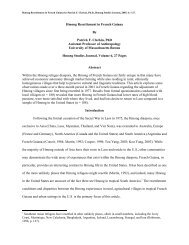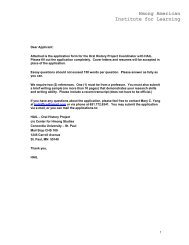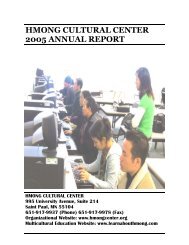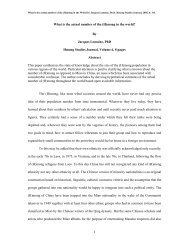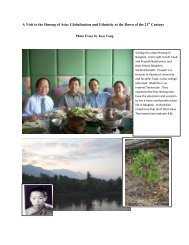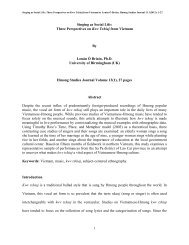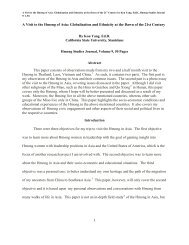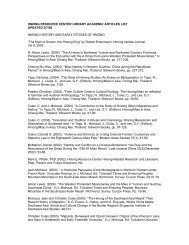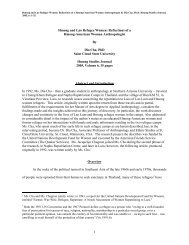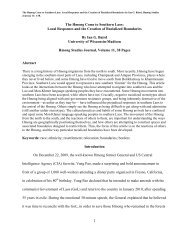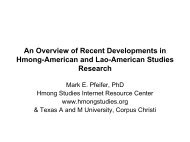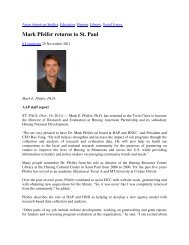Generation and Gender Roles in Hmong Society - Hmong Studies ...
Generation and Gender Roles in Hmong Society - Hmong Studies ...
Generation and Gender Roles in Hmong Society - Hmong Studies ...
- No tags were found...
Create successful ePaper yourself
Turn your PDF publications into a flip-book with our unique Google optimized e-Paper software.
Kou YangProfessor of Asian American <strong>Studies</strong>Ethnic <strong>and</strong> <strong>Gender</strong> <strong>Studies</strong> DepartmentCalifornia State University, Stanislaus© 2008 Kou Yang. No duplication without permission
The <strong>Hmong</strong> of Vietnam: <strong>Gender</strong> <strong>Roles</strong>© 2008 Kou Yang. No duplication without permissionMap <strong>and</strong> flag are from CIA World Factbook:https://www.cia.gov/library/publications/the-world-factbook/geos/vm.html
© 2008 Kou Yang. No duplication without permission
A <strong>Hmong</strong> coupe <strong>and</strong> their child© 2008 Kou Yang. No duplication without permission
© 2008 Kou Yang No duplication without permission• A father <strong>and</strong> his son
© 2008 Kou Yang. No duplication without permission• Older sister babysits for her younger sibl<strong>in</strong>gs
© 2008 Kou Yang. No duplication without permission• A young mother <strong>and</strong> her child <strong>in</strong> Can Cau, Bac Ha
At the Saturday Market Place <strong>in</strong> Can Cau2008 Kou Yang. No duplication without permission
Women come to themarket to sell theirproduces <strong>and</strong> othergoodsMany men cometo the market todr<strong>in</strong>k with theirfriends© 2008 Kou Yang. No duplication without permission
© 2008 Kou Yang. No duplication without permission• Like people of other countries, man does the driv<strong>in</strong>g
Globalization <strong>and</strong> adaptation© 2008 Kou Yang. No duplication without permissionIt is unusual for a woman to plough the family’s rice paddy field, but here itis; because her sons work <strong>in</strong> the city
Gather<strong>in</strong>g firewood© 2008 Kou Yang. No duplication without permission
The <strong>Hmong</strong> of Ch<strong>in</strong>a: <strong>Generation</strong> <strong>and</strong> <strong>Gender</strong><strong>Roles</strong>Mp <strong>and</strong> Flag are from CIA WorldFactbook:https://www.cia.gov/library/publications/the-world-factbook/geos/ch.html© 2008 Kou Yang No duplication without permissionCh<strong>in</strong>ese Flag <strong>and</strong> Map: from CIA World Factbook: L<strong>in</strong>k to
© 2008 Kou Yang. No duplication without permissionThis sculpture honors both man <strong>and</strong> woman Qeej masters as symbol of the <strong>Hmong</strong>
© 2008 Kou Yang. No duplication without permissionCook<strong>in</strong>g for the New Year Feast is the responsibility of the Men while cook<strong>in</strong>g forevery day is done by the women
© 2008 Kou Yang. No duplication without permission• New year feast<strong>in</strong>g: Men eat <strong>in</strong> a separate table
When parents hold their children, boy with dad <strong>and</strong> girl with mom© 2008 Kou Yang. No duplication without permission
A girl comes to the market with her mother© 2008 Kou Yang. No duplication without permission
© 2008 Kou Yang. No duplication without permission• Women do the sale
Both boys <strong>and</strong> girls play together© 2008 Kou Yang. No duplication without permission
© 2008 Kou Yang. No duplication without permissionThe wife feeds the animals while the husb<strong>and</strong> does the watch<strong>in</strong>g with their child
© 2008 Kou Yang. No duplication without permissionA gr<strong>and</strong> father <strong>and</strong> his gr<strong>and</strong> daughter
© 2008 Kou Yang. No duplication without permissionPlough the l<strong>and</strong> is usually man’s work: two men tra<strong>in</strong> a young ox to plough the l<strong>and</strong>
© 2008 Kou Yang. No duplication without permissionA mother <strong>and</strong> her adult daughter
© 2008 Kou Yang. No duplication without permissionEqual, but not so equal
A gr<strong>and</strong> father <strong>and</strong> his gr<strong>and</strong> child© 2008 Kou Yang. No duplication without permission
Two future Qeej masters play side by side© 2008 Kou Yang. No duplication without permission
© 2008 Kou Yang. No duplication without permission<strong>Gender</strong> equality: officials of both gender toast each other
© 2008 Kou Yang. No duplication without permissionA younger person offers a toast to her senior person
Men perform the Qeej <strong>and</strong> woman does the danc<strong>in</strong>g© 2008 Kou Yang. No duplication without permission
© 2008 Kou Yang. No duplication without permission<strong>Hmong</strong> museum pa<strong>in</strong>t<strong>in</strong>gs show women carry<strong>in</strong>g foods home <strong>and</strong> men perform<strong>in</strong>g the Qeej
Discussion Topics/Questions• Background:• History: list historical events that have contributed to the mak<strong>in</strong>g of<strong>Hmong</strong> patriarchal society• List some aspects of <strong>Hmong</strong> legend/folk tales that are related to gender<strong>in</strong>/equality or gender roles• Identify <strong>Hmong</strong> words that help you to underst<strong>and</strong> <strong>Hmong</strong> genderroles <strong>and</strong> issues• Identify some of the roles of the paternal gr<strong>and</strong>‐parents <strong>in</strong> the home?• List roles of maternal gr<strong>and</strong>‐parents that differ from paternal gr<strong>and</strong>parents• List some of the roles of the husb<strong>and</strong> <strong>and</strong> father• List some of the roles of the wife <strong>and</strong> mother
Discussion Topics/Questions• Agriculture <strong>and</strong> Geography• How do the climate <strong>and</strong> geography of the regions where<strong>Hmong</strong> live affect their patterns of generation/genderroles , <strong>and</strong> patriarchal practices• How do their agricultural practices affect their way oflife, culture <strong>and</strong> patterns of generation/gender roles• <strong>Hmong</strong> Language• Does <strong>Hmong</strong> language show preference for male orfemale?• What aspect of <strong>Hmong</strong> language <strong>and</strong> religion that might<strong>in</strong>dicate past matriarchal society
Discussion Topics/Questions• <strong>Hmong</strong> Religion <strong>and</strong> Culture• What aspects of <strong>Hmong</strong> culture <strong>and</strong> religion support theirpreference for boy over girl?• Do both maternal <strong>and</strong> paternal gr<strong>and</strong>‐parents have equal share ofcar<strong>in</strong>g <strong>and</strong> socializ<strong>in</strong>g their gr<strong>and</strong>‐children?• How is knowledge about various aspects of life passes on from onegeneration to the next?• People of Diaspora• Compare <strong>and</strong> contrast gender roles of the <strong>Hmong</strong> <strong>in</strong> differentcountries• Identify some of changes <strong>in</strong> gender roles among the <strong>Hmong</strong> <strong>in</strong> Laos,Ch<strong>in</strong>a, <strong>and</strong> Vietnam?
Discussion Topics/Questions• <strong>Hmong</strong> Americans• <strong>Gender</strong>/<strong>Generation</strong> roles• In which <strong>and</strong> what ways have gender roles changed <strong>in</strong> <strong>Hmong</strong>American society?• Donnelly (Donnelly, 1997: 113) found tremendous changes <strong>in</strong> theconduct of daily life of the <strong>Hmong</strong> <strong>in</strong> the US <strong>and</strong> stated thatchanges was proceed<strong>in</strong>g at lightn<strong>in</strong>g pace, too fast too record.Identify some of the changes?• List factors that <strong>in</strong>fluence the changes of gender roles <strong>in</strong> <strong>Hmong</strong>American society• Compare <strong>and</strong> contrast <strong>Hmong</strong> gender roles <strong>in</strong> Laos <strong>and</strong> <strong>in</strong> the US• Others:
References• Barney, George, L. Christianity: Innovation In Meo Culture A Case Study <strong>in</strong> Missionization. Unpublishedmaster's thesis. University of M<strong>in</strong>nesota (1957). http://www.como.stpaul.k12.mn.us/Vue‐Benson/.• Donnelly, Nancy D. Chang<strong>in</strong>g Lives of Refugee <strong>Hmong</strong> Women. Seattle: University ofWash<strong>in</strong>gton Press, 1994.• Geddes, W.R. Migrants of the Mounta<strong>in</strong>s. Oxford: Clarendon Press (1876).• Lemo<strong>in</strong>e, Jacques. “What is the actual number of the (H)mong <strong>in</strong> the World?” <strong>Hmong</strong><strong>Studies</strong> Journal, 6 (2005). Available from: http://hmongstudies.org/Lemo<strong>in</strong>eHSJ6.pdf• Lee, Gary Yia, Diaspora <strong>and</strong> the Predicament of Orig<strong>in</strong>s: Interrogat<strong>in</strong>g <strong>Hmong</strong> Postcolonial History <strong>and</strong>Identity. <strong>Hmong</strong> <strong>Studies</strong> Journal, Viol. 6 (2007). 1‐25._ _ _ _y_ _ _ _The <strong>Hmong</strong> of Laos: Overview of their Transnational Adaptation, a paperpresented at the first <strong>in</strong>ternational workshop on the <strong>Hmong</strong>/Miao <strong>in</strong> Asia 11‐13 September 1998,Aix‐en‐Provence, France (retrieved on May 13, 2008). L<strong>in</strong>k to view from:http://members.ozemail.com.au/~yeulee/Topical/hmong%20of%20laos.html#Demography%20<strong>and</strong>%20econom<strong>Hmong</strong> World View <strong>and</strong> Social Structure (Cited on November 10, 2008). L<strong>in</strong>k to viewfrom:http://home.vicnet.net.au/~lao/laostudy/hmrelate.htm_ _ _ _ The Shap<strong>in</strong>g of Traditions: Agriculture <strong>and</strong> <strong>Hmong</strong> <strong>Society</strong>. <strong>Hmong</strong> <strong>Studies</strong> Journal, Vol. 6(2005). 1‐33.• Hamilton‐Merritt, Jane. Tragic Mounta<strong>in</strong>s. Indianapolis: Indiana University Press, 1999.• Moua, Mai Neng. Bamboo Among the Oaks. St. Paul, MN: M<strong>in</strong>nesota Historical <strong>Society</strong> Press, 2002.
References• Olney, Douglas P. “We must be organized: dual organizations <strong>in</strong> an American <strong>Hmong</strong> community.”Ph.D. Diss., The University of M<strong>in</strong>nesota, 1993.• Pfeifer, Mark, <strong>and</strong> Serge Lee. “<strong>Hmong</strong> Population, Demographic, Socioeconomic, <strong>and</strong>Educational Trends <strong>in</strong> the 2000 Census.” In <strong>Hmong</strong> 2000 Census Publication: Data <strong>and</strong>Analysis. <strong>Hmong</strong> National Development, Inc., <strong>and</strong> the <strong>Hmong</strong> Cultural <strong>and</strong> ResourceCenter, 2004.• Ranard, D. (Editor), The <strong>Hmong</strong>: An Introduction to their History <strong>and</strong> Culture. The Center forApplied L<strong>in</strong>guistics, 2004.• Sw<strong>in</strong>kels, Rob <strong>and</strong> Carrie Turk, Expla<strong>in</strong><strong>in</strong>g Ethnic M<strong>in</strong>ority Poverty <strong>in</strong> Vietnam: a summary ofrecent trends <strong>and</strong> current challenges. Draft Background paper for CEM/ MPI meet<strong>in</strong>g onEthnic M<strong>in</strong>ority Poverty, Hanoi (28 September 2006). L<strong>in</strong>k to view from:Resources/Ethnic_M<strong>in</strong>ority_Poverty_<strong>in</strong>_Vietnam7.doc.• Toyota, Mika, Subjects of the Nation Without Citizenship: The Case of the ‘Hill Tribes <strong>in</strong>Northern Thail<strong>and</strong>. In, Kymlicka, Will <strong>and</strong> Baogang He, Multiculturalism <strong>in</strong> Asia, OxfordUniversity Press (2005). L<strong>in</strong>k to view from: google.com/books?isbn=0199277621.• Vuong Xuan T<strong>in</strong>h, Look<strong>in</strong>g for food: The Difficult Journey of the <strong>Hmong</strong> <strong>in</strong> Vietnam (No Date).L<strong>in</strong>k to view from: www.ies.wisc.edu/ltc/live/vxt0211loo.pdf• Yang, Dao. <strong>Hmong</strong> at The Turn<strong>in</strong>g Po<strong>in</strong>t. M<strong>in</strong>neapolis: WorldBridge Associates, 1993.‐‐‐‐‐‐‐ The <strong>Hmong</strong>: endur<strong>in</strong>g traditions. In Lewis, J. (Ed.), M<strong>in</strong>ority Cultures of Laos:Kammu, Lua, Lahu, <strong>Hmong</strong>, <strong>and</strong> Iu‐Mien. Rancho Cordova, CA: Southeast Asia CommunityResource Center‐Folsom Cordova Unified School District, 1992.
References• Yang, K., Contemporary <strong>Hmong</strong> Americans – In, L<strong>in</strong>g Hup<strong>in</strong>g, Emerg<strong>in</strong>g Voices: TheExperiences of Underrepresented Asian Americans, Rutgers University Press (2008)._____ <strong>Hmong</strong> Americans at the Dawn of the 21 st Century. Accepted to be presented at the16 th World Congress of the Union of Anthropological <strong>and</strong> Ethnological Sciences,Kunm<strong>in</strong>g, Ch<strong>in</strong>a (to be held from July 15 to 23, 2008; postpones until July 27‐30, 2009)._____ The Immigration <strong>and</strong> Emigration of <strong>Hmong</strong> Americans. Accepted to be presented atthe 16 th World Congress of the Union of Anthropological <strong>and</strong> Ethnological Sciences,Kunm<strong>in</strong>g, Ch<strong>in</strong>a (to be held from July 15 to 23, 2008; postpones until July 27‐30, 2009)._____ An Assessment of the <strong>Hmong</strong> American New Year <strong>and</strong> Its Implications for <strong>Hmong</strong>‐American Culture. <strong>Hmong</strong> <strong>Studies</strong> Journal, Vol.8 (2007). Onl<strong>in</strong>e l<strong>in</strong>k to view:http://hmongstudies.org/KYangHSJ8.pdf._____ Research Notes from the Field: Trac<strong>in</strong>g the Path of the Ancestors – A Visit to the<strong>Hmong</strong> <strong>in</strong> Ch<strong>in</strong>a.” <strong>Hmong</strong> <strong>Studies</strong> Journal 6 (2005):1‐38. Available from:http://hmongstudies.org/YangHSJ6.pdf.‐‐‐‐‐‐‐ <strong>Hmong</strong> Americans: 30 Years In‐Review. Paper presented at the First InternationalConference on Lao <strong>Studies</strong>, DeKalb: May 20‐22, 2005.‐‐‐‐‐‐‐ <strong>Hmong</strong> Americans: Felt Needs, Problems <strong>and</strong> Community Development. <strong>Hmong</strong><strong>Studies</strong> Journal, 4 (2003): 102‐124.‐‐‐‐‐‐‐ <strong>Hmong</strong> Diaspora of the Post‐War Period. Asian Pacific Migration Journal 12 (3) (2003). 271‐300._ _ _ _ <strong>Hmong</strong> Men’s Adaptation to Life <strong>in</strong> the United States. <strong>Hmong</strong> <strong>Studies</strong> Journal Vol. 1,No. 2 (1997).



